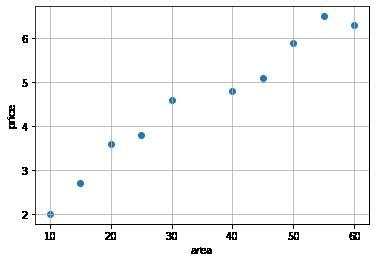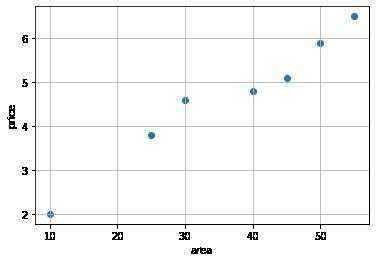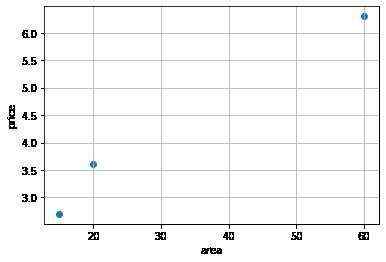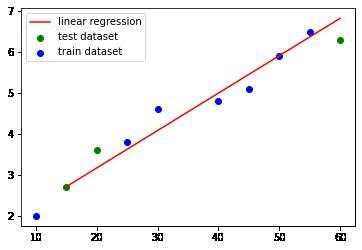线性回归的sklearn实现
导入必要的模块
import numpy as np
import pandas as pd
import matplotlib.pyplot as plt
from sklearn.model_selection import train_test_split
from sklearn.linear_model import LinearRegression
from sklearn.metrics import mean_squared_error
数据集
x = np.array([50, 30, 15, 40, 55, 20, 45, 10, 60, 25])
y = np.array([5.9, 4.6, 2.7, 4.8, 6.5, 3.6, 5.1, 2.0, 6.3, 3.8])
画出数据集的散点图
plt.scatter(x, y)
plt.grid(True)
plt.xlabel('area')
plt.ylabel('price')
plt.show()

数据划分
划分训练集和测试集
使用到的api:
数据划分sklearn.model_selection.train_test_split
用到的参数:
-
*arrays:输入数据集。
-
test_size:划分出来的测试集占总数据量的比例,取值0~1。
-
shuffle:是否在划分前打乱数据的顺序,默认True。
-
random_state:shuffle的随机种子,取值正整数。
返回:
- splitting:列表包含划分后的训练集与测试集。
x_train, x_test, y_train, y_test = train_test_split(
x, y, test_size=0.3, shuffle=True, random_state=23)
查看训练集的散点图
plt.scatter(x_train,y_train)
plt.grid('True')
plt.xlabel('area')
plt.ylabel('price')
plt.show()

查看测试集的散点图
plt.scatter(x_test,y_test)
plt.grid('True')
plt.xlabel('area')
plt.ylabel('price')
plt.show()

模型搭建
使用到的api:
线性回归sklearn.linear_model.LinearRegression
model = LinearRegression()
模型训练
使用到的api:
线性回归模型训练sklearn.linear_model.LinearRegression.fit
用到的参数:
x_train = x_train.reshape(-1,1)
model.fit(X=x_train, y=y_train)
LinearRegression()
模型预测
对测试集做预测
使用到的api:
线性回归模型预测sklearn.linear_model.LinearRegression.predict
用到的参数:
- X:输入特征,如果输入是np.array格式,shape必须是(n_sample, n_feature)。
返回:
x_test = x_test.reshape(-1,1)
y_test_pred = model.predict(x_test)
画出数据集的散点图和预测直线
x_test = x_test.reshape(-1)
plt.scatter(x_test, y_test, color='g', label='test dataset')
plt.scatter(x_train, y_train, color='b',label='train dataset')
plt.plot(np.sort(x_test), y_test_pred[np.argsort(x_test)], color='r', label='linear regression')
plt.legend()
plt.show()

计算评价指标mse
使用到的api:
均方误差sklearn.metrics.mean_squared_error
用到的参数:
返回:
mse = mean_squared_error(y_true=y_test, y_pred=y_test_pred)
print('MSE: {}'.format(mse))
MSE: 0.15383086014546365
查看线性回归模型的系数w和截距b
使用到的api:
回归系数sklearn.linear_model.LinearRegression.coef_
截距项sklearn.linear_model.LinearRegression.intercept_
w, b = model.coef_[0], model.intercept_
print('Weight={0} bias={1}'.format(w, b))
Weight=0.09139423076923077 bias=1.3420673076923069